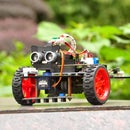Introduction: The Incredible Levitator Kit
In this Instructable,We can make the balls float in the air, and it truly appears as though pure magic!
Follow the easy steps below.
Note: requires we to assemble and welding.
Supplies
1 Main PCB+Top PCB
1 12V USB cable
3 ICs
2 Ultrasonic transducer
2 Capacitor
1 LED
1 Resistor
1 screwdrivers
1 power socket
some copper pillar
some screws
Foam balls or foam granule
You can bought them within one box: https://www.amazon.com/dp/B0CHF4D6S3
Step 1: Solder 3 Different ICs/ Chips
let's begin to solder, it requires a bit of skill. There are 3 different ICs/chips that you have to solder directly to the circuit board. They lay flat onto tracks on the board and we have to get them all soldered precisely in place--without overheating the board or the chips.
Step 2: Solder Different Kinds of Electronic Components
Solder the Capacitors, LED,Resistor, power socket in the corresponding position,the PCB is marked with the name of the components,so it is easy to find what goes where.
Note:some component have polarity, be sure to solder the Positive(+)of them to the hole marker (+)on the PCB.
Step 3: Solder Ultrasonic Transducer
Solder Ultrasonic Transducer to two PCB.
Step 4: Assemling
Use copper pillars and screws to build the frame as above.
Note:The length of the copper pillar between the two PCBs is 37mm. If it is too long or too short, it may affect the experimental results.
Step 5: Power
The USB cable is needed, we can power it via computer USB port or power bank.
Step 6: Let's Play With It Already!
Behold! A demonstration of The Incredible Levitator Kit ----four balls levitating in the air!
Step 7: Schematic Diagram
Step 8: More...
Ultrasonic Levitation:
Sound Waves:
Ultrasonic levitation involves using sound waves that are beyond the range of human hearing. These sound waves are called ultrasonic waves.
Frequency:
Imagine sound as waves like ripples on water. Sound waves have different frequencies, which determine how high or low the pitch is. Ultrasonic waves have frequencies higher than what humans can hear.
Levitation Principle:
The principle behind ultrasonic levitation is based on the fact that sound waves can carry energy. When you focus a concentrated beam of ultrasonic sound waves at an object, the waves can create pressure differences in the air.
Pressure Nodes:
In the air, there are regions of high pressure and low pressure called nodes and antinodes. Nodes are areas where the high-frequency sound waves reinforce each other, creating a stable point in the air. Antinodes are where the waves cancel each other out, creating areas of low pressure.
Levitating Objects:
If an object is placed at one of these nodes, it experiences a stable position where the pressure from the sound waves counteracts the force of gravity. This allows small objects to be levitated in mid-air!
Applications:
Scientists and researchers use ultrasonic levitation for various purposes, including studying materials in microgravity-like conditions or handling delicate objects without touching them.
Cool Fact:
Ultrasonic levitation is like creating an invisible "force field" with sound waves that can suspend objects in the air.
In summary, ultrasonic levitation uses high-frequency sound waves to create stable points in the air where objects can be suspended without any physical support. It's a fascinating application of physics with various practical uses!










![Tim's Mechanical Spider Leg [LU9685-20CU]](https://content.instructables.com/FFB/5R4I/LVKZ6G6R/FFB5R4ILVKZ6G6R.png?auto=webp&crop=1.2%3A1&frame=1&width=306)


